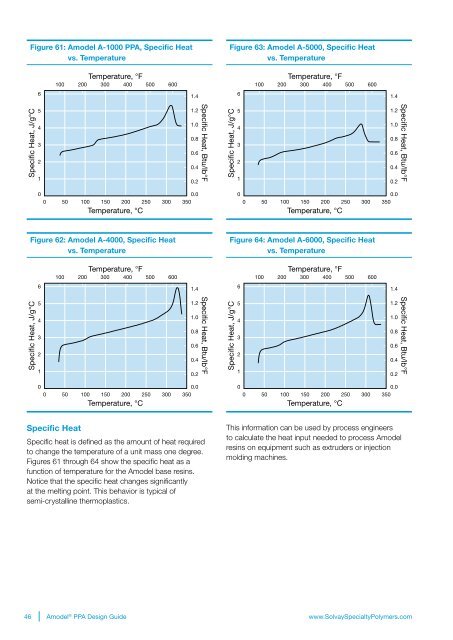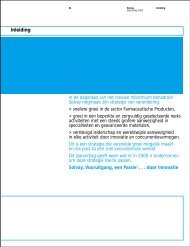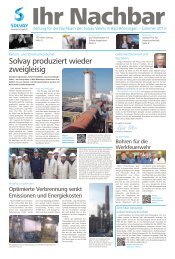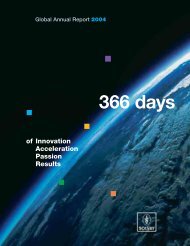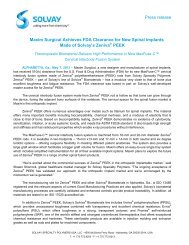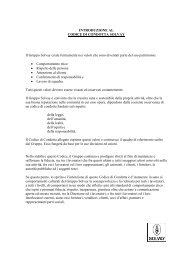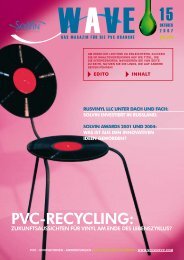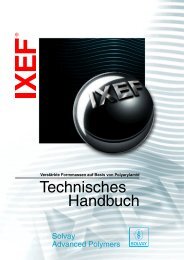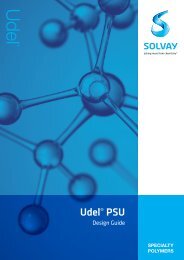Design Guide - Solvay Plastics
Design Guide - Solvay Plastics
Design Guide - Solvay Plastics
Create successful ePaper yourself
Turn your PDF publications into a flip-book with our unique Google optimized e-Paper software.
Figure 61: Amodel A-1000 PPA, Specific Heat<br />
vs. Temperature<br />
Figure 63: Amodel A-5000, Specific Heat<br />
vs. Temperature<br />
Temperature, °F<br />
100 200 300 400 500 600<br />
Temperature, °F<br />
100 200 300 400 500 600<br />
6<br />
1.4<br />
6<br />
1.4<br />
Specific Heat, J/g°C<br />
5<br />
4<br />
3<br />
2<br />
1<br />
1.2<br />
1.0<br />
0.8<br />
0.6<br />
0.4<br />
0.2<br />
Specific Heat, Btu/lb°F<br />
Specific Heat, J/g°C<br />
5<br />
4<br />
3<br />
2<br />
1<br />
1.2<br />
1.0<br />
0.8<br />
0.6<br />
0.4<br />
0.2<br />
Specific Heat, Btu/lb°F<br />
0<br />
0.0<br />
0 50 100 150 200 250 300 350<br />
Temperature, °C<br />
0<br />
0.0<br />
0 50 100 150 200 250 300 350<br />
Temperature, °C<br />
Figure 62: Amodel A-4000, Specific Heat<br />
vs. Temperature<br />
Figure 64: Amodel A-6000, Specific Heat<br />
vs. Temperature<br />
Temperature, °F<br />
100 200 300 400 500 600<br />
Temperature, °F<br />
100 200 300 400 500 600<br />
6<br />
1.4<br />
6<br />
1.4<br />
Specific Heat, J/g°C<br />
5<br />
4<br />
3<br />
2<br />
1<br />
1.2<br />
1.0<br />
0.8<br />
0.6<br />
0.4<br />
0.2<br />
Specific Heat, Btu/lb°F<br />
Specific Heat, J/g°C<br />
5<br />
4<br />
3<br />
2<br />
1<br />
1.2<br />
1.0<br />
0.8<br />
0.6<br />
0.4<br />
0.2<br />
Specific Heat, Btu/lb°F<br />
0<br />
0.0<br />
0 50 100 150 200 250 300 350<br />
Temperature, °C<br />
0<br />
0.0<br />
0 50 100 150 200 250 300 350<br />
Temperature, °C<br />
Specific Heat<br />
Specific heat is defined as the amount of heat required<br />
to change the temperature of a unit mass one degree.<br />
Figures 61 through 64 show the specific heat as a<br />
function of temperature for the Amodel base resins.<br />
Notice that the specific heat changes significantly<br />
at the melting point. This behavior is typical of<br />
semi-crystalline thermoplastics.<br />
This information can be used by process engineers<br />
to calculate the heat input needed to process Amodel<br />
resins on equipment such as extruders or injection<br />
molding machines.<br />
46 Amodel ® PPA <strong>Design</strong> <strong>Guide</strong><br />
www.<strong>Solvay</strong>SpecialtyPolymers.com


